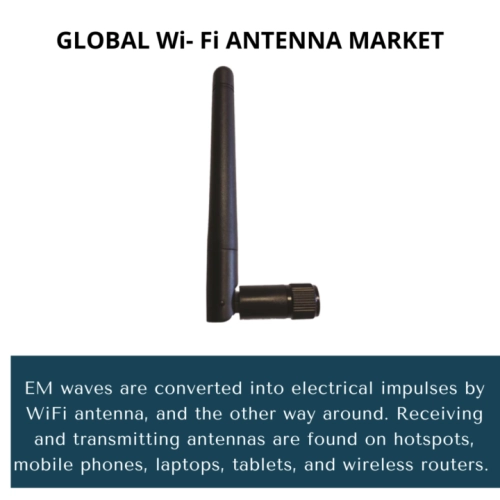
- Get in Touch with Us

Last Updated: Apr 25, 2025 | Study Period: 2022-2030
EM waves are converted into electrical impulses by WiFi antenna, and the other way around. Receiving and transmitting antennas are found on hotspots, mobile phones, laptops, tablets, and wireless routers.
Antennas are necessary for all wireless equipment to communicate. Some have outward, visible antennae, while others have invisible inside antennas. The radiation pattern is influenced by an antenna's form.
The omnidirectional or rod antenna is the most basic type of antenna. There are two types of radiation produced by antennas,horizontal radiation and vertical radiation.

The global wi-fi antenna market accounted for $XX Billion in 2021 and is anticipated to reach $XX Billion by 2030, registering a CAGR of XX% from 2022 to 2030.
In an era when demand for Wi-Fi networks is skyrocketing, next-generation Wi-Fi 6E lays the groundwork for wireless networks that are faster, better performing, and lower latency.
With its new internal Wi-Fi 6E antenna solutions, Laird Connectivity is reaffirming its status as the go-to antenna partner for businesses looking to leverage the potential of next-generation Wi-Fi.
The Wi-Fi 6E antenna solutions offered by Laird Connectivity make use of the PIFA topology, which is not only simpler to integrate into compact enclosures but also resists detuning when in close proximity to metal, a person, or other surfaces.
With consistent performance across all three Wi-Fi bands, PIFA technology always ensures a strong and dependable connection.
Broadcom Inc. unveiled the BCM4389, the first Wi-Fi 6E client device ever made. With broader 160 MHz channel bandwidths, Wi-Fi 6E expands the Wi-Fi 6 standard to include the soon-to-be-operational 6 GHz band, doubling Wi-Fi speeds and halving latency compared to Wi-Fi 5.
The BCM4389 is a perfect option for high-end smartphones and upcoming AR/VR devices since it offers real-world speeds of over 2 Gbps and up to five times better battery utilization.
The extensive feature set of Wi-Fi 6 continues with the addition of Wi-Fi 6E, which offers enhanced security, sophisticated roaming capabilities, and better performance in congested areas.
This Wi-Fi 6 upgrade employs brand-new airwaves in the 6 GHz band to give multi-gigabit speeds without interfering with existing devices.
The BCM4389 builds on the Wi-Fi 6 deployment that has already been increased, providing consumers with a constant, quick, and secure experience in combination with the more than million handsets that are currently available.
Wi-Fi 6E's additional advancements enable augmented reality and high-speed bi-directional video applications.
| Market Segmentation |
| Scope of the report |
| Abbreviations |
| Research Methodology |
| Executive Summary |
| Introduction |
| Insights from Industry stakeholders |
| Cost breakdown of Product by sub-components and average profit margin |
| Disruptive innovation in the Industry |
| Technology trends in the Industry |
| Consumer trends in the industry |
| Recent Production Milestones |
| Component Manufacturing in US, EU and China |
| COVID-19 impact on overall market |
| COVID-19 impact on Production of components |
| COVID-19 impact on Point of sale |
| Market Segmentation, Dynamics and Forecast by Geography, 2022-2030 |
| Market Segmentation, Dynamics and Forecast by Product Type, 2022-2030 |
| Market Segmentation, Dynamics and Forecast by Application, 2022-2030 |
| Market Segmentation, Dynamics and Forecast by End use, 2022-2030 |
| Product installation rate by OEM, 2022 |
| Incline/Decline in Average B-2-B selling price in past 5 years |
| Competition from substitute products |
| Gross margin and average profitability of suppliers |
| New product development in past 12 months |
| M&A in past 12 months |
| Growth strategy of leading players |
| Market share of vendors, 2022 |
| Company Profiles |
| Unmet needs and opportunity for new suppliers |
| Conclusion |
| Appendix |